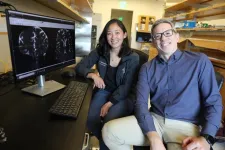(Press-News.org) Scientists have long theorized about a network of pathways in the brain that are believed to clear metabolic proteins that would otherwise build up and potentially lead to Alzheimer’s and other forms of dementia. But they had never definitively revealed this network in people — until now.
A new study involving five patients undergoing brain surgery at Oregon Health & Science University provides imaging of this network of perivascular spaces — fluid-filled structures along arteries and veins — within the brain for the first time.
“Nobody has shown it before now,” said senior author Juan Piantino, M.D., associate professor of pediatrics (neurology) in the OHSU School of Medicine and a faculty member of the Neuroscience Section of the Papé Family Pediatric Research Institute at OHSU. “I was always skeptical about it myself, and there are still a lot of skeptics out there who still don’t believe it. That’s what makes this finding so remarkable.”
The study published today in the Proceedings of the National Academy of Sciences.
The study combined the injection of an inert contrasting agent with a special type of magnetic resonance imaging to discern cerebrospinal fluid flowing along distinct pathways in the brain 12, 24 and 48 hours following surgery. In definitively revealing the presence of an efficient waste-clearance system within the human brain, the new study supports the promotion of lifestyle measures and medications already being developed to maintain and enhance it.
“This shows that cerebrospinal fluid doesn’t just get into the brain randomly, as if you put a sponge in a bucket of water,” Piantino said. “It goes through these channels.”
More than a decade ago, scientists at the University of Rochester first proposed the existence of a network of waste-clearance pathways in the brain akin to the body’s lymphatic system, part of the immune system. Those researchers confirmed it with real-time imaging of the brains of living mice. Due to its dependence on glial cells in the brain, they coined the term “glymphatic system” to describe it.
However, scientists had yet to confirm the existence of the glymphatic system through imaging in people.
Pathways revealed in patients
The new study examined five OHSU patients who underwent neurosurgery to remove tumors in their brains between 2020 and 2023. In each case, the patients consented to having a gadolinium-based inert contrasting agent injected through a lumbar drain used as part of the normal surgical procedure for tumor removal. The tracer would be carried with cerebrospinal fluid into the brain.
Afterward, each patient underwent magnetic resonance imaging, or an MRI, at different time points to trace the spread of cerebrospinal fluid.
Rather than diffusing uniformly through brain tissue, the images revealed fluid moving along pathways — through perivascular spaces in clearly defined channels. Researchers documented the finding with a specific kind of MRI known as fluid attenuated inversion recovery, or FLAIR. This type of imaging is sometimes used following the removal of tumors in the brain. As it turns out, it also revealed the gadolinium tracer in the brain, whereas the standard MRI sequences did not.
“That was the key,” Piantino said.
“You can actually see dark perivascular spaces in the brain turn bright,” said co-lead author Erin Yamamoto, M.D., a resident in neurological surgery in the OHSU School of Medicine. “It was quite similar to the imaging the Rochester group showed in mice.”
Clearing the waste from the brain
Scientists believe this network of pathways effectively flushes the brain of metabolic wastes generated by its energy-intensive work. Wastes include proteins such as amyloid and tau, which have been shown to form clumps and tangles in brain images of patients with Alzheimer’s disease.
Emerging research suggests medications that may be useful, but much of the focus around the glymphatic system has revolved around lifestyle-based measures to improve the quality of sleep, such as maintaining a regular sleep schedule, establishing a relaxing routine, and avoiding screens in the bedroom before bed. Especially at night during deep sleep, researchers believe a well-functioning glymphatic system efficiently carries waste proteins toward veins exiting the brain.
“People thought these perivascular spaces were important, but it had never been proven,” Piantino said. “Now it has.”
The authors credited the late Justin Cetas, M.D., Ph.D., who initiated the study as an OHSU neurosurgeon before leaving OHSU in to become chair of neurological surgery at his alma mater, the University of Arizona Health Sciences Center in Tucson. He died in a motorcycle accident in 2022.
In addition to Piantino and Yamamoto, authors included co-lead author Jacob H. Bagley, M.D., of OHSU and Aurora St. Luke’s Medical Center in Milwaukee; and co-authors Mathew Geltzeiler, M.D., associate professor of otolaryngology (head and neck surgery) in the OHSU School of Medicine; Olabisi R. Sanusi, M.D., assistant professor of neurological surgery in the OHSU School of Medicine; Aclan Dogan, M.D., professor of neurological surgery (skull base and cerebrovascular) in the OHSU School of Medicine; and Jesse J. Liu, M.D., assistant professor of neurological surgery (skull base and cerebrovascular) in the OHSU School of Medicine.
The research was supported by a Medical Research Foundation of Oregon Early Clinical Investigator grant; the North American Skull Base Society; and by the National Heart, Lung and Blood Institute of the National Institutes of Health, grant awards K23HL150217 and R21HL167077. The content is solely the responsibility of the authors and does not necessarily represent the official views of the NIH.
END
Brain’s waste-clearance pathways revealed for the first time
OHSU study uses imaging in neurosurgery patients to show how brain’s glymphatic system clears waste; lifestyle measures can keep system sharp
2024-10-07
ELSE PRESS RELEASES FROM THIS DATE:
Plenty more fish in the sea? Environmental protections account for around 10 percent of fish stocks on coral reefs
2024-10-07
EXPERT AVAILABLE
Embargoed until Tuesday 8 October at 06:00 AEDT
New research from the University of Sydney shows that international conservation efforts account for approximately 10 percent of fish stocks on coral reefs.
The global study, published in Proceedings of the National Academy of Sciences, was led by Professor Joshua Cinner from the School of Geosciences and lead analyst Dr Iain Caldwell from the Wildlife Conservation Society. The international research team also included scientists from US, UK, Kenya, France and Germany among others.
Looking at fish survey data across nearly 2,600 tropical ...
Macaques give birth more easily than women: no maternal mortality at birth
2024-10-07
An international research team led by the University of Vienna and the Medical University of Vienna has used long-term demographic data from Japanese macaques – a monkey species within the family of Old World monkeys – to show that, unlike humans, there is no maternal mortality in these primates linked to childbirth. The results of the study were recently published in the renowned scientific journal PNAS.
The evolution of large brains and associated large fetal heads are key factors linked to maternal mortality in primates during childbirth. For humans, the baby's large head in relation ...
Five George Mason researchers receive funding for Center for Climate Risks Applications
2024-10-07
Five George Mason Researchers Receive Funding For Center For Climate Risks Applications
Luis Ortiz, Assistant Professor, Atmospheric, Oceanic and Earth Sciences (AOES), College of Science; Fengxui Zhang, Assistant Professor, Schar School of Policy and Government; Edward Oughton, Assistant Professor, Geography and Geoinformation Science, College of Science; Natalie Burls, Associate Professor, AOES, and Director, Climate Dynamics Program, College of Science; and James Kinter, Director, Center for Ocean-Land-Atmosphere Studies (COLA); Director, ...
Advancing CRISPR: Lehigh University engineering researchers to develop predictive models for gene editing
2024-10-07
CRISPR is a revolutionary tool that allows scientists to precisely modify the genome and gene expression of cells in any organism. It’s a reagent—a substance that facilitates a reaction—that combines an enzyme with a programmable RNA capable of locating specific genetic sequences. Once guided to the correct spot, the enzyme acts like a pair of scissors, cutting, replacing, or deleting sequences of DNA.
Researchers are now using the technology to, among many things, treat genetic diseases, develop medical therapeutics, and design diagnostic tools.
“CRISPR is very powerful, but it comes with side effects,” says Lehigh University ...
Protecting confidentiality in adolescent patient portals
2024-10-07
Weill Cornell Medicine researchers found that the possibility of parental disclosure through online patient portals led older adolescents to hesitate in sharing complete health information with doctors, putting them at risk of missed diagnoses and treatments. The paper noted that confidentiality concerns were increased among females and those who are sexual and gender minorities.
The results, published Oct. 7 in JAMA Pediatrics, are based on a national online survey that targeted 18 to 26 years olds who ...
Gatling conducting digitization project
2024-10-07
Benjamin Gatling, Associate Professor, English, College of Humanities and Social Sciences (CHSS), is set to receive funding for a project in which he will digitize a significant portion of the archive of the Folklore Fund at the Rudaki Institute of Language and Literature in Dushanbe, Tajikistan.
Gatling aims to train local archive staff in best practices, the preservation of materials, and digitization and metadata creation for the majority of the archive’s holdings, as well as the curation of digitized materials.
The archive’s holdings include bound notebooks, notecards, ...
Regenstrief researcher awarded $1.9 million CDC grant
2024-10-07
INDIANAPOLIS -- Jill Inderstrodt, PhD, MPH, has received notification of a five-year, $1.9 million collaborative grant to improve health and the care of people living with congenital heart defects (CHD).
Awarded by the Centers for Disease Control and Prevention, Dr, Inderstrodt will lead a multidisciplinary team from the Indiana University Fairbanks School of Public Health and the Regenstrief Institute. Also part of the research team is Brian Dixon, PhD, MPA, a Regenstrief researcher, Fairbanks School professor and interim director of the Regenstrief Center for Biomedical Informatics.
“I am honored to lead this initiative alongside ...
Independent expert report: The Human Brain Project significantly advanced neuroscience
2024-10-07
The European Commission (EC) has released the 10-year assessment of the Human Brain Project (HBP), an EU-Flagship initiative that concluded in 2023. The report was authored by a panel of independent scientific experts. Their assessment of the HBP’s development and results over the full 10 years comes to a strongly positive conclusion. The report highlights that the HBP made major contributions and had a transformative impact on brain research. One of the main outcomes of the HBP is EBRAINS, the open research infrastructure ...
Wu conducting molecular modeling of DR domain of HIV restriction factor PSGL-1
2024-10-07
Yuntao Wu, Professor, Molecular and Microbiology, School of Systems Biology, College of Science, is studying the structure of dicameric repeats (DR) of PSGL-1, a host protein that inhibits HIV virion infectivity.
These are repeated stretches of 10 amino acids with numerous O-glycosylated threonines and prolines.
Wu and his collaborators hypothesize that the structural rigidity and glycosylation of dicameric repeats affect anti-HIV activity.
The researchers have two aims.
First, they aim to determine the structure-function of DR.
Second, they intend to test and validate the anti-HIV activity of PSGL-1 (P-selectin glycoprotein ligand 1) that inactivates ...
Nguyen working to make complex invariants accessible
2024-10-07
Thanhvu Nguyen, Associate Professor, Computer Science, College of Engineering and Computing (CEC), received funding from the National Science Foundation for the project: “Collaborative Research: FMitF: Track II: From Theory to Practice: Making Complex Invariants Accessible with DIG.”
Nguyen and his collaborators are developing the invariant generator DIG-I, which is more efficient and scalable than other invariant generators. It also has applications beyond just invariant discovery. The researchers hold that DIG-I will be ...
LAST 30 PRESS RELEASES:
The Ceramic Society of Japan’s Oxoate Ceramics Research Association launches new international book project
Heart-brain connection: international study reveals the role of the vagus nerve in keeping the heart young
Researchers identify Rb1 as a predictive biomarker for a new therapeutic strategy in some breast cancers
Survey reveals ethical gaps slowing AI adoption in pediatric surgery
Stimulant ADHD medications work differently than thought
AI overestimates how smart people are, according to HSE economists
HSE researchers create genome-wide map of quadruplexes
Scientists boost cell "powerhouses" to burn more calories
Automatic label checking: The missing step in making reliable medical AI
Low daily alcohol intake linked to 50% heightened mouth cancer risk in India
American Meteorological Society announces Rick Spinrad as 2026 President-Elect
Biomass-based carbon capture spotlighted in newly released global climate webinar recording
Illuminating invisible nano pollutants: advanced bioimaging tracks the full journey of emerging nanoscale contaminants in living systems
How does age affect recovery from spinal cord injury?
Novel AI tool offers prognosis for patients with head and neck cancer
Fathers’ microplastic exposure tied to their children’s metabolic problems
Research validates laboratory model for studying high-grade serous ovarian cancer
SIR 2026 delivers transformative breakthroughs in minimally invasive medicine to improve patient care
Stem Cell Reports most downloaded papers of 2025 highlight the breadth and impact of stem cell research
Oxford-led study estimates NHS spends around 3% of its primary and secondary care budget on the health impacts of heat and cold in England
A researcher’s long quest leads to a smart composite breakthrough
Urban wild bees act as “microbial sensors” of city health.
New study finds where you live affects recovery after a hip fracture
Forecasting the impact of fully automated vehicle adoption on US road traffic injuries
Alcohol-related hospitalizations from 2016 to 2022
Semaglutide and hospitalizations in patients with obesity and established cardiovascular disease
Researchers ‘listen in’ to embryo-mother interactions during implantation using a culture system replicating the womb lining
How changing your diet could help save the world
How to make AI truly scalable and reliable for real-time traffic assignment?
Beyond fragmented markets: A new framework for efficient and stable ride-pooling
[Press-News.org] Brain’s waste-clearance pathways revealed for the first timeOHSU study uses imaging in neurosurgery patients to show how brain’s glymphatic system clears waste; lifestyle measures can keep system sharp






